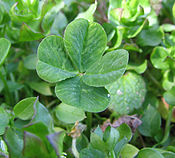Four-leaf clover
The four-leaf clover is an uncommon variation of the common, three-leaved clover. According to tradition, such leaves bring good luck to their finders, especially if found accidentally.[1] According to legend, each leaf represents something: the first is for hope, the second is for faith, the third is for love, and the fourth is for luck.[citation needed]
Clovers can have more than four leaves: the most ever recorded is twenty-one,[2] a record set in June 2008 by the same man who held the prior record and the current Guinness World Record of eighteen.[3] Unofficial claims of discovery have ranged as high as twenty-seven.[2]
It has been estimated that there are approximately 10,000 three-leaf clovers for every four-leaf clover,[4] however this probability has not deterred collectors who have reached records as high as 160,000 four-leaf clovers.[5] It is debated whether the fourth leaflet is caused genetically or environmentally. Its relative rarity suggests a possible recessive gene appearing at a low frequency. Alternatively, four-leaf clovers could be caused by somatic mutation or a developmental error of environmental causes. They could also be caused by the interaction of several genes that happen to segregate in the individual plant. It is possible all four explanations could apply to individual cases.[citation needed]
Researchers from the University of Georgia have reported finding the gene that turns ordinary three-leaf clovers into the coveted four-leaf types. Masked by the three-leaf gene and strongly influenced by environmental condition, molecular markers now make it possible to detect the presence of the gene for four-leaves and for breeders to work with it. The results of the study, which also located two other leaf traits in the white-clover genome, were reported in the July/August 2010 edition of Crop Science, published by the Crop Science Society of America.[6]
The other leaf traits, the red fleck mark and red midrib, a herringbone pattern that runs down the center of each leaflet in a bold red color, were mapped to nearby locations, resolving a century-old question as to whether these leaf traits were controlled by one gene or two separate genes.
White clover has many genes that affect leaf color and shape, and the three in the study were very rare. These traits can be strikingly beautiful, particularly if combined with others, and can turn clover into an ornamental plant for use in flower beds.
Certain companies produce four-leaf clovers using different means.[citation needed] Richard Mabey alleges, in Flora Britannica, that there are farms in the US which specialize in four-leaf clovers, producing as many as 10,000 a day (to be sealed in plastic as "lucky charms") by feeding a secret, genetically-engineered ingredient to the plants to encourage the aberration (there are, however, widely-available cultivars that regularly produce leaves with multiple leaflets – see below). Mabey also states that children learn that a five-leaved clover is even luckier than a four-leaved one.[7] Five-leaf clovers are less commonly found naturally than four-leaf clovers;[8][9] however, they, too, have been successfully cultivated.[10]
Other plants may be mistaken for, or misleadingly sold as, "four-leaf clovers"; for example, Oxalis tetraphylla is a species of wood sorrel with leaves resembling a four-leaf clover.[11][12] Other species that have been sold as "four-leaf clovers" include Marsilea quadrifolia.[13][14]
Contents |
[edit] Multi-leaved cultivars
There are some cultivars of white clover (Trifolium repens) which regularly produce more than three leaflets, including purple-leaved T. repens 'Purpurascens Quadrifolium' and green-leaved T. repens 'Quadrifolium'.[15]
Trifolium repens 'Good Luck' is a cultivar which has three, four, or five green, dark-centered leaflets per leaf.[16]
[edit] See also
- 4-H emblem
- Alfa Romeo cloverleaf or Quadrifoglio badges denote variants of cars where the name denotes the high-end of the range in comfort and engine size, but previously denoted Alfa Romeo racing cars in the pre-Second-World-War era
- Celtic F.C. badge, featuring the four leaf clover
- Cloverleaf interchange
- Cloverleaf quasar
- Horseshoe
- I'm Looking Over a Four Leaf Clover
- Quatrefoil, a four-lobed structure
- Rabbit's foot
- Shamrock
- The Co-operative brand, The Co-operative's former logo, introduced in 1968 and refreshed in 1993
- The political Centre Parties of Estonia, Finland, Norway and Sweden all use a four-leaf clover as their logo
- Yotsuba&!
[edit] References
- ^ Mabey, Richard, Flora Britannica, Sinclair-Stevenson, London, 1996, p. 225. ISBN 1-85619-377-2
- ^ a b 21-leaf Clover Sets Record. Neatorama. Retrieved 7 December 2008.
- ^ Clover - Most Leaves. Guinness World Record. Retrieved 7 December 2008. - (illustrating a stem with eighteen leaflets discovered in Hanamaki City, Japan, in May 2002)
- ^ Bradley, David. Five-leaf Clovers. ScienceBase.com. 31 October 2008.
- ^ Levitt, Steven D. 160,000 Four-Leaf Clovers? New York Times. 25 May 2008.
- ^ Tashiro, R.M., et al. Leaf Trait Coloration in White Clover and Molecular Mapping of the Red Midrib and Leaflet Number Traits. Crop Science 7 June 2010.
- ^ Mabey, Richard, Flora Britannica, p. 225 (citing Edward and Helene Wenis of Leonia, New Jersey, USA, writing in BSBI News, 56, 1990)
- ^ Hershey, David R. Re: how common is a five leaf clover?. MadSci.org. 16 March 2000.
- ^ Facts About Five-leaf Clovers. FourLeafClover.com. Retrieved 7 December 2008.
- ^ Five-leaf clover. Mt. Vernon Register-News. 14 October 2008.
- ^ The Four Leaf Clover Kit (Mega Mini Kits) (Paperback). Amazon review. 12 September 2006.
- ^ Good Luck Plant Kit. FourLeafClover.com. Retrieved 7 December 2008.
- ^ All About Shamrocks Four-Leaf Clovers. LollySmith.com. Retrieved 7 December 2008.
- ^ Keenan, Susan M. The Four Leaf Clover. HotFact.com. 11 March 2008.
- ^ Lord, Tony (ed), RHS Plant Finder 2006–2007, (20th edition), Dorling Kindersley, London, 2006, p. 743. ISBN 1-4053-1455-9
- ^ Killerplants.com (photo)

